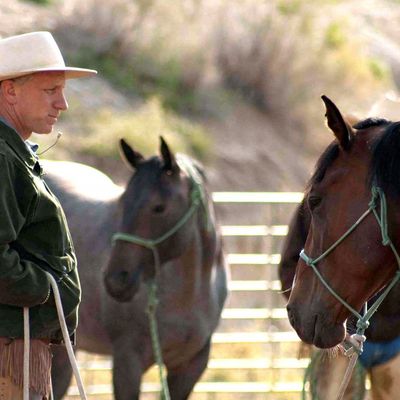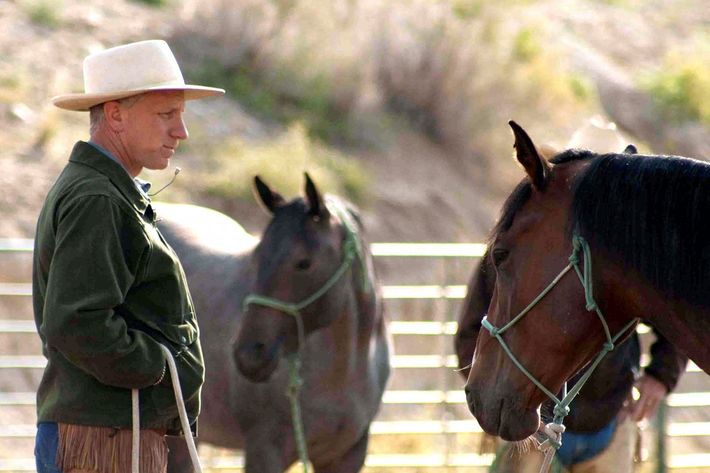

Our therapeutic culture is lousy with stories of people struggling to spin childhood traumas into something that leaves the world a better place than the one that damaged them, but IÔÇÖve never seen a film in which the link between a trauma and its triumphant transmutation is as vivid as in Buck. Cindy MeehlÔÇÖs shambling yet uncannily beautiful documentary tells the story of Buck Brannaman, a rangy, bow-legged cowboy who travels the country 40 weeks a year hosting four-day clinics. Brannaman was an adviser on the film of The Horse Whisperer and the moniker is often attached to him, but IÔÇÖd call him the Horse Empath. He sees himself through the animalsÔÇÖ eyes and feels their childlike skittishness, their primal fear.
That empathy, it turns out, has roots in his past as the child of an abusive drunk who drilled him and his brother in the showbiz art of rope tricks ÔÇö and also, after their mother died, beat them mercilessly for inexplicable infractions. Then a coach saw BuckÔÇÖs ravaged back, the sheriff stepped in, and he and his brother went to live with a couple named the Shirleys, whose mode with the terrified child was firm but gentle. One of the first things his foster father taught him was how to shoe horses.
ItÔÇÖs well and good to hear Buck and other talking heads tell his story, but the film wouldnÔÇÖt come to much if you didnÔÇÖt feel the connection between his present and past in every frame. Heartbreaking historical footage of horses being whipped, ÔÇ£broken,ÔÇØ gives way to Buck hypnotically fluttering thin little flags in front of the creatures, pausing between motions for the animals to settle themselves.
The pace is transfixing. Other than The Black Stallion, horse movies tend to be choppy, edited around the animals, so their natural rhythms disappear into the space between the frames. Meehl, in her directing debut, is attuned to the rhythms of Buck, whoÔÇÖs attuned to the horses. ÔÇ£EverythingÔÇÖs a dance,ÔÇØ he explains from atop the saddle ÔÇö and suddenly he and the horse have launched into a sideways canter so graceful, so unified, that Fred Astaire would stop and salute.
Buck does hint at darker aspects of its subject. Hes a loving but absent father, although one of his daughters helps out in his clinics and wields a pretty fair lasso. The climactic episode breaks Bucks easy stride: an encounter with a violent, brain-damaged-at-birth horse that has been badly raised and is now, Buck says, a predator. The state of the horse, he lectures the owner, tells him quite a bit about her  and then, in a grimly prolonged shot, he calms the furious creature so that it lopes into the trailer that will carry it to its death. The horse didnt fail us, says Buck. We failed him. He could be talking about the person he might have become  or any child brought into a world of grown-ups who dont look, listen, or feel.
Andrew RossiÔÇÖs documentary Page One: Inside the New York Times spends a couple of minutes on the eponymous front page (what leads, what goes on page two) before jumping around the paperÔÇÖs headquarters like an overeager puppy. Rossi evidently cottoned early on to media writer David Carr, who becomes the de facto protagonist, both a lively personality and someone who examines, on a daily basis, the overarching question: Can AmericaÔÇÖs best newspaper survive in this new multi-platform world? An ex-drug addict, Carr is quick on the uptake and pugnaciously defends the Times against any and all who belittle it: His evisceration on a panel of clammy aggregator Michael Wolff is a mighty moment. But a hipster like Carr is an odd figure on which to center this portrait. HeÔÇÖs the diametric opposite of the prototypical Times lifer and no reflection of its historic culture.
What Rossi misses is that until recently, the Times was contemptuous of other media. Rival papers were only reluctantly cited, and if a subject wasnÔÇÖt covered, it didnÔÇÖt, in the editorsÔÇÖ view, exist. WritersÔÇÖ idiosyncratic voices were determinedly ironed out, and anything that undermined the paperÔÇÖs faux objectivity was viewed with distaste. (I once freelanced a story on a Lord of the Rings marathon, and the editor cut the most intriguing quote, from a fangirl, on the grounds that ÔÇö this is an exact quotation ÔÇö he ÔÇ£would never socialize with such a person.ÔÇØ) Rossi touches glancingly on the scandals of Judith Miller and Jayson Blair but only to show how they hurt the paperÔÇÖs reputation, not as products of institutional arrogance. And he does a half-assed job portraying the paperÔÇÖs dalliance with Julian Assange, whom editors regarded with palpable squeamishness and whose trove of information they barely examined.
That said, the Times is now without peer, and Rossi catches its writersÔÇÖ and editorsÔÇÖ tireless sense of responsibility, which mostly transcends their pretentiousness. And its culture is changing for the better, unlike its rivalsÔÇÖ. One of CarrÔÇÖs big stories is the Chicago-based Tribune mess featuring the destructive, Gollum-like publisher Sam Zell. Thank God the Times would never socialize with such a person.


